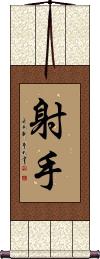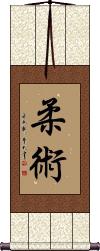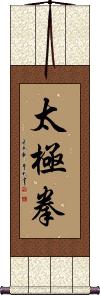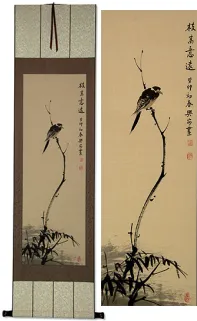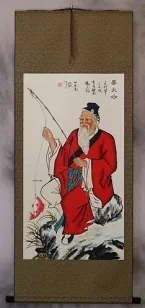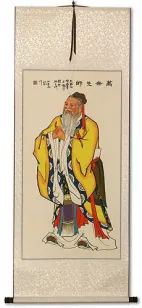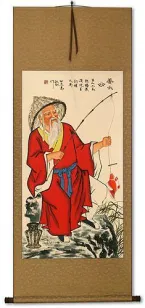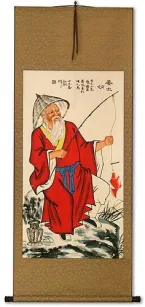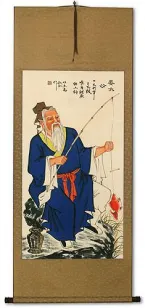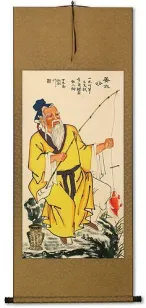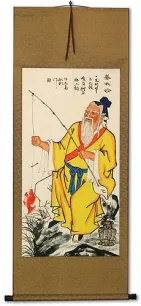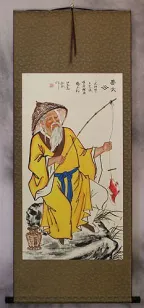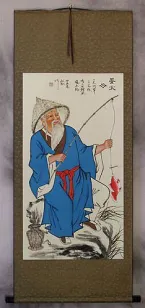Many custom options...
And formats...

Not what you want?
Try other similar-meaning words, fewer words, or just one word.
Old Hand in Chinese / Japanese...
Buy an Old Hand calligraphy wall scroll here!
Personalize your custom “Old Hand” project by clicking the button next to your favorite “Old Hand” title below...
Hand-to-Hand Fighting / Grappling
Kakuto
Law of the Fist Karate / Kempo Karate
The first two characters mean “fist law” which is Romanized from Japanese as “Kenpo” or “Kempo.”
The last two are a secondary way to express “karate.”
Notes:
The more common way to express “karate” is literally “empty hand” (meaning “without weapons in your hand”). This version would be translated literally as “Tang hand” (as in the Tang Dynasty) or “China hand” (sometimes “Tang” means “China” in Japanese). Even though the character for “Tang” is used instead of “empty,” it's still pronounced “kara-te” in Japanese.
拳法唐手 is not commonly used in China - so please consider it to be a Japanese-only title.
Many Japanese people will say the last two Kanji are the old and antiquated way of saying Karate. This fact does not stop this title from existing, as these four characters are often seen in Kenpo / Kempo Dojos around the western world.
Archer
射手 means archer, shooter, or marksman in Chinese, Japanese Kanji, and old Korean Hanja.
Depending on the context, it can also mean “goal-getter” in Chinese. This would also be the word for a bowman.
射手 is modern in Asia, meaning that it's only been in use for a few hundred years. However, the more ancient version of the archer is often not even recognized by the current generation of Chinese and Japanese people.
The first character means “shoot” or “fire” (in the context of a gun or bow). It's also a suffix for radioactive things (in the context of chemistry) - radioactive things “fire off” electrons. In Japanese, the first Kanji is a short name and suffix for archery.
The second character means “hand,” but the hand can also mean a person, in the same way, that a “farmhand” is a person in English.
Jujitsu / Jujutsu
柔術 has been somewhat incorrectly spelled and pronounced “Jujitsu” for some time in the English-speaking world. The correct Japanese Romaji is Jujutsu or Juujutsu.
A little background on the word: By combining the Kanji pronounced “Ju” (which means flexible, pliable, gentle, yielding) with the Kanji pronounced “Jutsu” (which means art or technique), we get a meaning that can be translated as “flexible technique,” “gentle art” or “yielding technique.”
柔術 does make sense in Chinese as well, although pronounced “rou shu” in China.
The Jujutsu system has a history in Japan that started well before the 1600s. Some see this style as a variation of the “Empty Hand Method” (Karate-do). Even the samurai of old used some Jujutsu methods in defending themselves with their unarmed hands against weapons that could pierce their heavy armor.
There are convoluted relationships between various schools and systems of martial arts, but it's generally accepted that Jujutsu led to the development of Judo and a few other variations.
Tai Chi Chuan / Tai Ji Quan
太極拳 is the famous Taoist meditation and martial art exercise. The direct translation of these characters would be something like “grand ultimate fist,” but that does not quite hit the mark for what this title really means.
An early-morning walk through any city in China near a park or an open area will yield a view of Chinese people practicing this ancient technique.
A typical scene is an old man of no less than 80 years on this earth, with a wispy white beard and perhaps a sword in one hand. He makes slow moves that are impossibly smooth. He is steady-footed and always in balance. For him, time is meaningless and proper form, and technique is far more important than speed.
For the younger generation, faster moves may look impressive and seem smooth to the casual observer. But more discipline and mental strength are needed to create perfectly smooth moves in virtual slow motion.
Note: There are two ways to Romanize these Chinese characters, as seen in the title above. The pronunciation and actual characters are the same in Chinese. If you really used English sounds/words to pronounce this, it would be something like “tie jee chew-on” (make the “chew-on” one flowing syllable).
This in-stock artwork might be what you are looking for, and ships right away...
Gallery Price: $67.00
Your Price: $36.88
Gallery Price: $200.00
Your Price: $98.88
Gallery Price: $200.00
Your Price: $78.88
Gallery Price: $200.00
Your Price: $78.88
Gallery Price: $67.00
Your Price: $36.88
Not the results for old hand that you were looking for?
Below are some entries from our dictionary that may match your old hand search...
| Characters If shown, 2nd row is Simp. Chinese |
Pronunciation Romanization |
Simple Dictionary Definition |
倌 see styles |
guān guan1 kuan |
keeper of domestic animals; herdsman; (old) hired hand in certain trade |
右 see styles |
yòu you4 yu migi みぎ |
(bound form) right; right-hand side; (bound form) (politics) right of center; (bound form) (old) west; (literary) the right side as the side of precedence (noun - becomes adjective with の) (1) (See 左・1) right; right-hand side; (2) right hand; (noun - becomes adjective with の) (3) the above (in a piece of vertical writing); above-mentioned; (4) the right (wing); rightist; (female given name) Yū dakṣiṇa. The right hand, on the right, e. g. |
役 see styles |
yì yi4 i yaku やく |
forced labor; corvée; obligatory task; military service; to use as servant; to enserf; servant (old); war; campaign; battle (1) role; assignment; responsibility; duty; function; job; service; (2) position (of responsibility); post; office; (3) part (in a play, film, etc.); role; character; (4) {mahj;cards;hanaf} scoring combination; hand; yaku; meld; (given name) Mamoru |
甲 see styles |
jiǎ jia3 chia kou / ko こう |
first of the ten Heavenly Stems 十天干[shi2 tian1 gan1]; (used for an unspecified person or thing); first (in a list, as a party to a contract etc); letter "A" or roman "I" in list "A, B, C", or "I, II, III" etc; armor plating; shell or carapace; (of the fingers or toes) nail; bladed leather or metal armor (old); ranking system used in the Imperial examinations (old); civil administration unit in the baojia 保甲[bao3 jia3] system (old); ancient Chinese compass point: 75° (1) carapace; shell; (2) 1st in rank; grade A; (3) instep; back of hand; (4) {law} (See 乙・おつ・1) the A party (e.g. in a contract); the first party; plaintiff (label in legal documents); (surname) Yoroi Scale, mail; the first of the ten 'celestial stems '. |
笏 see styles |
hù hu4 hu shaku しゃく |
(old) ceremonial tablet (held by officials at an audience) shaku; flat wooden or ivory baton carried in the right hand when in ceremonial imperial or Shinto garb |
中古 see styles |
zhōng gǔ zhong1 gu3 chung ku chuuko(p); chuuburu / chuko(p); chuburu ちゅうこ(P); ちゅうぶる |
medieval; Middle Ages; Chinese middle antiquity, 3rd to 9th centuries, including Sui and Tang Dynasties; Middle (of a language, e.g. Middle English); used; second-hand (can be adjective with の) (1) used; second-hand; old; (2) (ちゅうこ only) Middle Ages (in Japan esp. Heian period); (surname) Chuuko |
健者 see styles |
shitatakamono したたかもの |
(1) strong-willed person; old hand; shrewd rascal; wily fox; desperate character; formidable woman; (2) strong man; brave man |
叉手 see styles |
chā shǒu cha1 shou3 ch`a shou cha shou shashu |
The palms of the hands together with the fingers crossed forming ten. Also, the palms together with the middle fingers crossing each other, an old Indian form of greeting. In China anciently the left hand was folded over the right, but with women the right hand was over the left. In mourning salutations the order was reversed. |
古兵 see styles |
furutsuwamono ふるつわもの kohei / kohe こへい |
old soldier; veteran; old hand |
慣家 惯家 see styles |
guàn jia guan4 jia5 kuan chia |
(usually derog.) an old hand at something |
老手 see styles |
lǎo shǒu lao3 shou3 lao shou roushu / roshu ろうしゅ |
experienced person; an old hand at something veteran; past master |
老牌 see styles |
lǎo pái lao3 pai2 lao p`ai lao pai |
old, well-known brand; old style; old school; an old hand; experienced veteran |
老鳥 老鸟 see styles |
lǎo niǎo lao3 niao3 lao niao rouchou / rocho ろうちょう |
old hand; veteran old bird |
舊書 旧书 see styles |
jiù shū jiu4 shu1 chiu shu |
second-hand book; old book; ancient book |
中國通 中国通 see styles |
zhōng guó tōng zhong1 guo2 tong1 chung kuo t`ung chung kuo tung |
China watcher; an expert on China; an old China hand |
健か者 see styles |
shitatakamono したたかもの |
(1) strong-willed person; old hand; shrewd rascal; wily fox; desperate character; formidable woman; (2) strong man; brave man |
古強者 see styles |
furutsuwamono ふるつわもの |
old soldier; veteran; old hand |
古武士 see styles |
furutsuwamono ふるつわもの kobushi こぶし |
old soldier; veteran; old hand; (1) feudal warrior; samurai; (2) old soldier; veteran; old hand |
強か者 see styles |
shitatakamono したたかもの |
(1) strong-willed person; old hand; shrewd rascal; wily fox; desperate character; formidable woman; (2) strong man; brave man |
老司機 老司机 see styles |
lǎo sī jī lao3 si1 ji1 lao ssu chi |
(coll.) an old hand at something |
ベテラン see styles |
beteran ベテラン |
(noun - becomes adjective with の) person with a lot of experience; old hand; veteran (in a particular field) |
手揉み茶 see styles |
temomicha てもみちゃ |
tea rolled by hand over a dryer (old production method); hand-rolled tea |
老馬識途 老马识途 see styles |
lǎo mǎ shí tú lao3 ma3 shi2 tu2 lao ma shih t`u lao ma shih tu |
an old horse knows the way (idiom); an experienced worker knows what to do; an old hand knows the ropes |
ヴェテラン see styles |
reteran ヴェテラン |
(noun - becomes adjective with の) person with a lot of experience; old hand; veteran (in a particular field) |
したたか者 see styles |
shitatakamono したたかもの |
(1) strong-willed person; old hand; shrewd rascal; wily fox; desperate character; formidable woman; (2) strong man; brave man |
Variations: |
furutsuwamono; kohei(古兵); kobushi(古武士) / furutsuwamono; kohe(古兵); kobushi(古武士) ふるつわもの; こへい(古兵); こぶし(古武士) |
(1) (こぶし only) feudal warrior; samurai; (2) old soldier; veteran; old hand |
Variations: |
shitatakamono したたかもの |
(1) strong-willed person; old hand; shrewd rascal; wily fox; desperate character; formidable woman; (2) strong man; brave man |
Variations: |
beteran(p); bederan; reteran ベテラン(P); ベデラン; ヴェテラン |
(noun - becomes adjective with の) veteran (in a particular field); person with a lot of experience; old hand |
Variations: |
orosu おろす |
(transitive verb) (1) to take down; to bring down; to lower (a hand, flag, shutter, etc.); to drop (an anchor, curtain, etc.); to let down (hair); to launch (a boat); (transitive verb) (2) (esp. 降ろす) to drop off (a passenger); to let off; to unload (goods, a truck, etc.); to offload; to discharge; (transitive verb) (3) to withdraw (money); (transitive verb) (4) to use for the first time; to wear for the first time; (transitive verb) (5) to cut off; to fillet (fish); to grate (e.g. radish); to prune (branches); (transitive verb) (6) (esp. 降ろす) to remove (someone from a position); to oust; to drop; (transitive verb) (7) to clear (the table); to remove (offerings from an altar); to pass down (e.g. old clothes); to hand down; (transitive verb) (8) (See 堕ろす) to expel from the body (e.g. worms); to abort (a fetus); (transitive verb) (9) to invoke (a spirit); to call down |
The following table may be helpful for those studying Chinese or Japanese...
| Title | Characters | Romaji (Romanized Japanese) | Various forms of Romanized Chinese | |
| Hand-to-Hand Fighting Grappling | 格闘 / 挌闘 格闘 | kakutou / kakuto kakuto / kakuto | ||
| Law of the Fist Karate Kempo Karate | 拳法唐手 | ken pou kara te kenpoukarate ken po kara te | quán fǎ táng shǒu quan2 fa3 tang2 shou3 quan fa tang shou quanfatangshou | ch`üan fa t`ang shou chüanfatangshou chüan fa tang shou |
| Archer | 射手 | i te / sha shu ite / shashu | shè shǒu / she4 shou3 / she shou / sheshou | |
| Jujitsu Jujutsu | 柔術 柔术 | juu jutsu / juujutsu / ju jutsu | róu shù / rou2 shu4 / rou shu / roushu | jou shu / joushu |
| Tai Chi Chuan Tai Ji Quan | 太極拳 太极拳 | tai kyoku ken taikyokuken | tài jí quán tai4 ji2 quan2 tai ji quan taijiquan | t`ai chi ch`üan taichichüan tai chi chüan |
| In some entries above you will see that characters have different versions above and below a line. In these cases, the characters above the line are Traditional Chinese, while the ones below are Simplified Chinese. | ||||
Successful Chinese Character and Japanese Kanji calligraphy searches within the last few hours...


